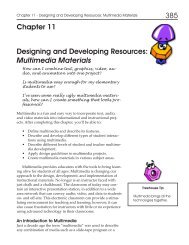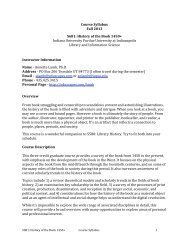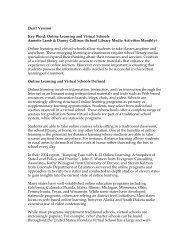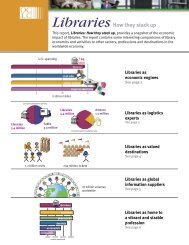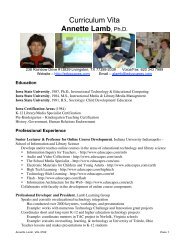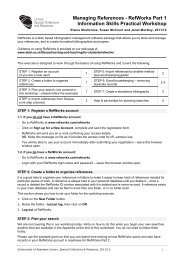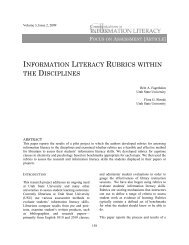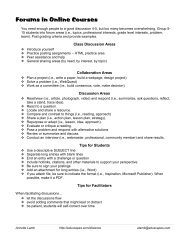Jamie McKenzie developed the âQuestioning Toolkit ... - eduScapes
Jamie McKenzie developed the âQuestioning Toolkit ... - eduScapes
Jamie McKenzie developed the âQuestioning Toolkit ... - eduScapes
You also want an ePaper? Increase the reach of your titles
YUMPU automatically turns print PDFs into web optimized ePapers that Google loves.
<strong>Jamie</strong> <strong>McKenzie</strong> <strong>developed</strong> <strong>the</strong> “Questioning <strong>Toolkit</strong>” to help young people distinguish<br />
among different types of questions (1997, p. 1).<br />
Essential Questions are central to our lives and<br />
touch our hearts and souls. They probe deep into<br />
issues that reflect <strong>the</strong> complexity of life. They<br />
often deal with abstractions and <strong>the</strong> “how” and<br />
“why” of people, places, and things.<br />
Should ATVs be allowed in<br />
wilderness areas?<br />
Subsidiary Questions are smaller queries that<br />
often lead to larger insights. They’re sometimes<br />
combined toge<strong>the</strong>r to ask larger questions.<br />
What’s <strong>the</strong> impact of ATVs<br />
on <strong>the</strong> soil?<br />
Hypo<strong>the</strong>tical Questions explore possibilities and<br />
test relationships. They are useful when making<br />
decisions and solving problems. They’re often<br />
“what if” questions.<br />
What if everyone drove off-road<br />
with <strong>the</strong>ir ATV?<br />
Telling Questions focus an investigation on<br />
specific evidence. Information is ga<strong>the</strong>red<br />
leading to a specific target.<br />
How long does it take for <strong>the</strong> soil to recover<br />
from “off-road” ATV use?<br />
Planning Questions help students organize <strong>the</strong>ir<br />
thinking, structure <strong>the</strong>ir investigation, and<br />
sequence activities.<br />
What source would have <strong>the</strong><br />
best statistics on ATV use?<br />
Organizing Questions help structure<br />
information in meaningful ways.<br />
What patterns can we find<br />
in ATV use?<br />
Probing Questions ask students to apply logic,<br />
connect to prior knowledge, use intuition, and<br />
experiment with data to acquire useful evidence.<br />
What are <strong>the</strong> fundamental concerns<br />
regarding ATVs and <strong>the</strong> environment?<br />
Sorting & Sifting Questions focus on <strong>the</strong><br />
relevance of information in addressing a<br />
particular need.<br />
173<br />
Is <strong>the</strong> information found at <strong>the</strong> U.S. Forest<br />
Service website regarding ATV use reliable?
174<br />
Clarification Questions help students define words<br />
and concepts, examine <strong>the</strong> logic of an argument,<br />
and identify <strong>the</strong> underlying assumptions.<br />
Strategic Questions arise during <strong>the</strong> inquiry process<br />
as students are exploring, assimilating, inferring,<br />
and reflecting.<br />
What do we mean by “off-road use” and<br />
“wilderness area”?<br />
What’s <strong>the</strong> best way to ga<strong>the</strong>r information<br />
on illegal, off-road ATV use?<br />
Elaborating Questions extend and expand findings by<br />
asking students to look for implicit (unstated) meanings.<br />
Unanswerable Questions explore those areas where<br />
truth may never be found. Students must understand<br />
that some problems may not be solved.<br />
Inventive Questions encourage <strong>the</strong> discovery of new<br />
ideas or rethinking of existing approaches.<br />
Provocative Questions challenge <strong>the</strong> status quo by<br />
promoting doubt and skepticism. They may explore<br />
irony, satire, and parody.<br />
Irrelevant Questions distract students from <strong>the</strong>ir<br />
original questions, but <strong>the</strong>se diversions are sometimes<br />
useful in finding new, relevant directions.<br />
What if ATV groups and environmental<br />
organizations worked toge<strong>the</strong>r to<br />
establish ATV trails in areas adjacent<br />
to wilderness areas?<br />
If wilderness areas have already been<br />
touched by humans, are <strong>the</strong>y truly wild?<br />
What if I just concentrated on <strong>the</strong> impact<br />
of illegal ATV use?<br />
How could <strong>the</strong> ATV craze actually help<br />
environmentalists protect more land<br />
by illustrating how easily it’s destroyed?<br />
What is it about ATVs that get<br />
environmentalists so worked up?<br />
Divergence Questions explore topics adjacent to <strong>the</strong><br />
original questions, but issues that might be connected.<br />
Irreverent Questions challenge students to think<br />
outside <strong>the</strong> box. Although <strong>the</strong>y may seem disrespectful<br />
or impolite to some, <strong>the</strong>y may generate important<br />
discussions about key issues.<br />
Where do mountain bikes fit into <strong>the</strong><br />
discussion of wilderness access?<br />
Why not ban all humans from<br />
wilderness areas to keep <strong>the</strong>m wild?






